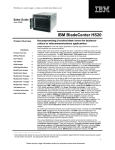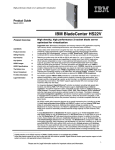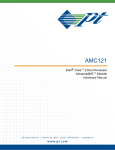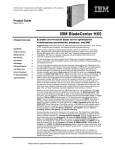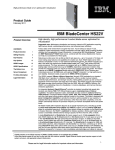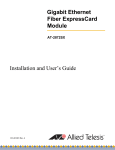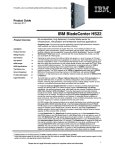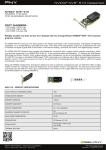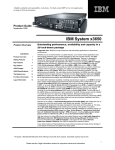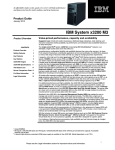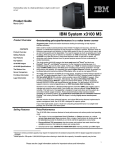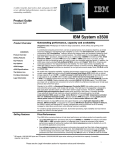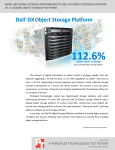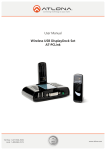Download IBM HS21 User's Manual
Transcript
Workhorse 2-socket dual and quad-core Intel Xeon blade server Product Guide November 2006 IBM BladeCenter HS21 Uncompromising 2-socket blade server for businesscritical or telecommunications applications Product Overview [Suggested uses: Front-and mid-tier applications requiring high performance, enterprise-class availability and extreme flexibility and power efficiency.] CONTENTS Product Overview 1 Selling Features 2 Key Features 4 Key Options 12 HS21 Images 13 HS21 Specifications 13 BladeCenter Images 16 BladeCenter Specs 16 BladeCenter H Images 17 BladeCenter H Specs 18 BladeCenter T Images 19 BladeCenter T Specs 19 The Bottom Line 20 Server Rec. Map 22 For More Information 23 Legal Information 23 Today’s data center environment is tougher than ever. You are looking to reduce IT cost, complexity, space requirements, power consumption and heat output, while increasing flexibility, utilization and manageability. Incorporating IBM X-Architecture™ features, the IBM® BladeCenter® HS21 blade server, combined with the various BladeCenter chassis, can help you accomplish all of these goals. Reducing an entire server into as little as .5U of rack space does not mean trading away features and capabilities for smaller size. Each HS21 blade server offers features comparable to many 1U rack-optimized full-featured servers: The HS21 supports up to two of the latest fullperformance/low-power-draw quad- and dual-core Intel® Xeon® processors. The Xeon processors are designed with 4MB (dual-core) or 8MB (quad-core) of L2 cache, a leading-edge 1066 or 1333MHz front-side bus (FSB), and 64-bit extensions (EM64T), to help provide the computing power you require to match your business needs and growth. The HS21 supports up to 32GB of 667MHz PC2-5300 Fully Buffered ECC (Error Checking and Correcting) double data rate II (DDR2) memory in 8 DIMM slots, using the Memory and I/O Expansion Unit, with optional Chipkill™ protection, for high performance and reliability. The base HS21 is packaged into a single 30mm form factor and supports up to 16GB of memory in 4 DIMM slots. Integrated dual Gigabit Ethernet1 controllers are standard, providing high-speed data transfers and offering TOE (TCP Offload Engine) support, load-balancing and failover capabilities. The Memory and I/O Expansion Unit provides two additional Gigabit Ethernet controllers (without TOE support). Via optional expansion cards, each blade can also connect to additional Ethernet, Myrinet, Fibre Channel, iSCSI, InfiniBand™, and other high-speed communication switches housed in the chassis. Optional 2-port Expansion Cards add additional fabrics to the HS21 server as needed. This blade is designed with power management capability to provide the maximum uptime possible for your systems. In extended thermal conditions or power brownouts, rather than shut down completely, or fail, the HS21 automatically reduces the processor frequency to maintain acceptable thermal and power levels. All HS21 models offer impressive features at an equally impressive price, including up to two SAS hard disk drives, with RAID-0 data striping or RAID-1 disk mirroring support. An optional 30mm Storage and I/O Expansion Unit connects to a blade (model-dependent) to provide an additional three 2.5” SAS HDDs with hot-swap support, optional RAID-5 with battery-backed cache, and four additional communication ports. Moreover, the HS21 is optimized for diskless operation, offering each blade server access to essentially unlimited storage capacity via Fibre Channel or iSCSI. A single BladeCenter or BladeCenter H chassis supports up to 14 hot-swappable 30mm-wide HS21 blades in only 7U (BladeCenter) or 9U (BladeCenter H) of rack space or up to 8 hotswappable blades in the rugged 8U BladeCenter T chassis. Plans call for supporting up to 8 HS21 NEBS-3/ETSI-compliant blades in a telecommunications environment. In addition to the blade servers, these chassis also hold up to four (BladeCenter/BladeCenter T) communication switches, or up to ten switches/bridges (BladeCenter H) internally. Not only can this save significant data center space (and therefore the cost of floor space and rack hardware) compared to 1U servers, it also consolidates switches/bridges and cables for reduced complexity and lower cabling costs, and allows clients to manage everything in the solution as one. Using a BladeCenter chassis, up to 84 HS21 servers (168 processors) can be installed in one industry-standard 42U rack but the value of BladeCenter extends far beyond high density data center environments. 1 Actual data transfer speed will vary and is often less than the maximum possible. Gigabit Ethernet transfer speed requires support on both system and server, and appropriate network infrastructure. Please see the Legal Information section for important notices and information. 1. Workhorse 2-socket dual and quad-core Intel Xeon blade server The various BladeCenter chassis are designed to monitor environmental conditions in the chassis and each blade and send alerts to the administrator. Advanced standard features, such as Active Memory™, Predictive Failure Analysis™, light path diagnostics, hot-swap redundant power supplies and blower modules with Calibrated Vectored Cooling™; IPMI 2.0 support, including highly secure remote power control; text-console redirect over LAN, a Management Module (upgradeable with a redundant MM), IBM Director management software including IBM PowerExecutive™, Remote Deployment Manager, and IBM ServerGuide™ help maintain system availability with increased uptime. If you need highly manageable, high-performance computing power in a space- or powerconstrained environment, the HS21 is the ideal system. Selling Features Price/Performance • There is an HS21 model to fit all budgets. The HS21 offers a choice of high-performance multi-core Xeon processors with low-power draw, 64-bit extensions, either a 1066MHz or a 1333MHz front side bus and either 8MB or 4MB (processor-specific) of shared integrated Level 2 cache. • Low-voltage processors draw less power and produce less waste heat than high-voltage processors, thus helping to reduce data center energy costs. Some dual-core Xeon processors use only 65W. This is half the wattage consumed by older 130W processors. On a per-core basis, the 80W quad-core processors are even more economical, consuming only 20W per core, vs. 32.5W per core for the 65W dual-core processors. For even lower dual-core power utilization, consider processors operating at 40W and even 35W (20W and 17.5W per core, respectively.) • Fully buffered PC2-5300 ECC memory operates at 667MHz with dual-interleaving, for high performance. • Selected HS21 blade servers are NEBS3/ETSI-compliant and feature long-life availability. These blades are ideal for telecom or Next Generation Network (NGN) applications such as IPTV, IP Multimedia Subsystem (IMS) and security. • The extremely high degree of integration in the various BladeCenter chassis reduces the need for server components, replacing numerous fans, KVM and Ethernet cables, power supplies, external switches and other components with fewer shared hot-swap/redundant components in the BladeCenter chassis itself. This integration also can greatly reduce the amount of power consumed and heat produced, relative to an equivalent number of 1U servers. This can significantly reduce a data center’s power bill. The reduced datacenter footprint can also save on infrastructure cost. • The chassis midplane provides high-speed blade-to-blade, blade-to-switch-module and module-to-module communication internally as well as externally. The midplane in the BladeCenter H provides four 10Gb data channels to each blade, and supports 4X InfiniBand and 10Gb Ethernet high-speed switch modules. • The various BladeCenter chassis use ultrahigh efficiency power supplies. Most industrystandard servers use power supplies that are between 65-75% efficient at converting power from AC wall current to the DC power used inside servers. BladeCenter power modules can be more than 90% efficient. This helps save even more money, as more of the power input you are paying for is used for processing, rather than released into the data center as waste heat. • BladeCenter also reduces the number of parts required to run the system. Sharing fans, systems management, floppy devices and media means fewer parts to buy and maintain, and fewer items that can bring the solution down. Flexibility The HS21 has the ability to grow with your application requirements, thanks to: • Up to two multi-core Xeon processors (four or eight cores in all). • Up to 16GB (standard) or 32GB (using the optional Memory and I/O Expansion Unit) of highspeed fully buffered 667MHz PC2-5300 DDR2 error checking and correcting (ECC) system memory with optional Chipkill protection. • Up to two internal 2.5-inch SAS HDDs, up to three 2.5-inch SAS HDDs in an adjacent Storage and I/O Expansion Unit, and access to terabytes of external IBM System Storage™ and IBM TotalStorage™ SAN and NAS storage devices. 2.5-inch drives consume approximately half the power of 3.5-inch drives. • Two Gigabit Ethernet ports standard; plus more, using either a 2-port Gigabit Ethernet Expansion Card, a Memory and I/O Expansion Unit, or a PCI I/O Expansion Unit II. In addition, the various BladeCenter chassis offer a high degree of flexibility: • A 30mm HS21 blade server can be upgraded, via a Memory and I/O Expansion Unit to a doublewide HS21 (with expanded capabilities). With or without the Memory and I/O Expansion Unit, the blade can be expanded further with a Storage and I/O Expansion Unit and/or a PCI I/O Expansion Unit. This expandability allows configurations that are 30mm, 60mm, 90mm or 120mm Please see the Legal Information section for important notices and information. 2. Workhorse 2-socket dual and quad-core Intel Xeon blade server wide, with a variety of memory, storage and I/O options, depending on need. • Xeon processor-based HS21 blades can be used in the same chassis as Intel processor-based HS20/HS40 blades, Opteron processor-based LS20/LS21/LS41 blades, and IBM PowerPC® processor-based JS20/JS21 blades. Depending on the blade servers used, the various BladeCenter chassis support Microsoft Windows, Linux, Netware, IBM AIX® and Sun Solaris 10 operating systems in the same chassis. • Every HS/LS/JS blade server ever released by IBM is supported in BladeCenter H, and most are supported in every BladeCenter chassis ever released, going back to 2002. Every switch module released by IBM is equally compatible. (Ask HP and Dell how far back their compatibility goes.) Future blades and fabric switches are expected to continue to be compatible with previous chassis for the foreseeable future. • A blade server has access to as many as 10 communication switches and/or bridges in one BladeCenter H chassis. (Up to 6 switches in a BladeCenter or BladeCenter T chassis.) And the switches can be Ethernet, iSCSI, InfiniBand, Fibre Channel, Myrinet, or anything else designed and ServerProven for BladeCenter use. Switches, bridges and interface cards are currently available from such vendors as Brocade, Cisco, Intel, McData, Nortel, QLogic, Cisco Topspin and others, in addition to IBM. Manageability • The HS21 blade server includes a Baseboard Management Controller (BMC) to monitor server availability, perform Predictive Failure Analysis, etc., and trigger IBM Director alerts. • Each BladeCenter chassis includes a Management Module or Advanced Management Module to provide additional systems management capabilities, including Web-based out-of-band control; virtual floppy and CD-ROM support; Windows “blue screen” error capture; LDAP and SSL support; and remote redirection of video, text, keyboard and mouse. • Integrated industry-standard IPMI 2.0 support works with the BMC to alert IBM Director to anomalous environmental factors, such as voltage and thermal conditions. It also supports highly secure remote power control. • IBM PowerExecutive, an IBM-exclusive, is designed to take advantage of new system power management features, by monitoring actual power usage and providing power consumption capping features. More accurate power usage data helps with data center construction planning and the sizing of power and cooling needs, as well as allowing you to use available power more efficiently. • The HS21 supports an optional feature card that provides concurrent KVM (cKVM) and concurrent media (cMedia) access by multiple administrators at once. (This card uses a dedicated slot and does not affect the use of PCI-X/PCI-E adapters.) • IBM Director 5.1x is included for proactive systems management and works with both the blade’s internal BMC and the chassis’ management module. It comes with a portfolio of tools, including IBM PowerExecutive, Management Processor Assistant, RAID Manager, Update Assistant, and Software Distribution. In addition, IBM Director offers extended systems management tools for additional server management and increased availability. When a problem is encountered, IBM Director can issue administrator alerts via e-mail, pager, and other methods. Availability and Serviceability • BladeCenter chassis are designed for operation with greatly reduced potential for single points of failure. Most aspects of operation, from blade servers to communication modules, to management modules, to power and blower modules, are hot-swappable. The midplane connections are redundant and the other features can be made so, when used in pairs. • HS21 blade servers support the use of Chipkill-enabled memory DIMMs. Chipkill memory can be up to 16X better than standard ECC memory at correcting some types of memory errors. This can help reduce downtime caused by memory errors. • IPMI 2.0 supports highly secure remote system power on/off using data encryption. This allows an administrator to restart a server without having to visit it in person, saving travel time and getting the server back up and running quickly and securely. • Environmentally tuned blower modules in the chassis adjust to compensate for changing thermal characteristics. At the lower speeds they draw less power and suffer less wear. Equally important in a crowded data center, temperature-controlled blowers produce less ambient noise in the data center than if they were constantly running at full speed. • Text and graphics console redirection support allows the administrator to remotely view HS21 2 For terms and conditions or copies of the IBM Statement of Limited Warranty, call 800-772-2227 in the U.S. In Canada call 800-426-2255. Telephone support may be subject to additional charges. For warranties including onsite labor, a technician is sent after IBM attempts to resolve the problem remotely. International warranty service is available in any country in which this product is sold. Please see the Legal Information section for important notices and information. 3. Workhorse 2-socket dual and quad-core Intel Xeon blade server text and graphic messages over serial or LAN connections. • A standard three-year (parts and labor) limited onsite warranty2 affords you peace of mind and greater potential investment protection. IBM Systems Agenda The philosophy behind the design of the HS21 and the various BladeCenter Chassis involves four major aspects, Openness, Collaborative Innovation, Virtualization, and Technology Innovation that Matters: • Unlike competitive blade solutions, many parts of the BladeCenter specifications have been made open. Hundreds of vendors have downloaded the specifications, and dozens so far have released products designed specifically for BladeCenter, including Brocade, Topspin, Cisco, Nortel, Emulex, and others. This provides a wider selection of options to better fit your needs than a purely proprietary offering could. • IBM has collaborated with industry leaders to offer innovative solution packages for specific industry segments, including banking, retail, telco and others. In addition, IBM formed Blade.org, a planned collaborative organization, to focus on accelerating the expansion of solutions for BladeCenter. Founding members in the blade.org community include Brocade, Citrix Systems, Intel Corporation, Network Appliances, Nortel, Novell and VMware. • IBM offers virtualization capabilities in a number of ways: desktop virtualization via Hosted Clients, InfiniBand virtualization and native blade virtualization. • Technology for technology’s sake is pointless. Instead IBM BladeCenter focuses on technological innovation that provides real customer benefits. Examples of this include a high degree of blade and module compatibility across all chassis, the use of fewer and lower-power components to enable significant power and cooling savings, and hot-swap and redundant components that reduce single points of failure. Key Features Intel Xeon Processors The HS21 supports up to two identical Xeon processors (that is, the same clock rate and cache size and the same number of cores). The choice of processors includes: • 80W quad-core Xeon processor models 5310, 5320, and 5345 at 1.6, 1.86, or 2.33GHz (respectively), with 64-bit extensions, reduced power draw, a 1066MHz (1.6 or 1.86GHz) or 1333MHz (2.33GHz) FSB, and 8MB of shared L2 processor cache; supported in all BladeCenter chassis. • 80W dual-core Xeon processor model 5160 at 3.0GHz, with 64-bit extensions, low power draw, a 1333MHz FSB, and 4MB of shared L2 processor cache; supported in all BladeCenter chassis. • 65W dual-core Xeon processor models 5110 or 5120 at 1.6 or 1.86GHz (respectively), with a 1066MHz FSB, or models 5130, 5140, or 5150 at 2.0, 2.33, or 2.66GHz, with a 1333MHz FSB. These processors feature 64-bit extensions, impressive performance/watt and 4MB of shared L2 processor cache. Select models also feature an embedded processor with long life support as well as NEBS 3/ETSI compliance. Supported in all BladeCenter chassis. • 40W dual-core Xeon processor model 5148 at 2.33GHz, with 64-bit extensions, ultralow power draw, a 1333MHz FSB, and 4MB of shared L2 processor cache; supported in all BladeCenter chassis. • 35W dual-core Xeon processor model 5138 at 2.13GHz, with 64-bit extensions, ultralow power draw, a 1066MHz FSB, and 4MB of shared L2 processor cache; supported in all BladeCenter chassis. This processor is a long-life, embedded offering, intended for a NEBS environment. The dual-core Xeon processors contain two complete processor cores; quad-core processors, similarly, contain four cores. The processors also contain one unified shared 4MB (dual-core) or 8MB (quad-core) cache. The shared cache is dynamically allocated between the cores as needed. The two cores appear to software as two physical processors. The dual-core processors offer considerably higher performance than a same-speed Xeon processor with a single core. Likewise, quad-core processors offer considerably higher performance than a same-speed Xeon processor with dual cores. Intelligent Power Capability powers individual processor elements on and off as needed, to reduce power draw. Intel Extended Memory 64 Technology (EM64T) 64-bit extensions allow Xeon processors to use large memory addressing when running with a 64-bit operating system. This can result in higher performance. Additional registers and instructions (SSE3) can further boost performance for applications written to use them. Contact your software providers to determine their software support for EM64T. DDR II ECC Fully Buffered Memory with Chipkill Protection The HS21 ships with PC2-5300 fully-buffered double data rate II (DDR II) memory (operating Please see the Legal Information section for important notices and information. 4. Workhorse 2-socket dual and quad-core Intel Xeon blade server at 667MHz) for faster access, and provides Active Memory features, including advanced Chipkill memory protection (using 1GB or larger DIMMs), for up to 16X better error correction than standard ECC memory. The HS21 supports up to 16GB of memory in four DIMM slots. Adding a 30mm Memory and I/O Expansion Unit doubles the memory support to 32GB in eight DIMM slots. The fully buffered memory in the HS21 provides up to triple the memory bandwidth (up to 21.3GBps in four channels of PC2-5300 fully-buffered DIMMs vs. a maximum of 6.4GBps in two channels of unbuffered PC2-3200 memory. By performing reads and writes simultaneously, it eliminates the previous memory read-to-write blocking latency. In addition, it also offers innovative data reliability and security features to help improve data integrity, including enhanced CRC protection, data retry on error detect and buffer registers for improved fault isolation. For increased availability, the HS21 offers two additional (but mutually exclusive) levels of IBM Active Memory protection: online memory mirroring, and online hot-spare memory. Memory mirroring works much like disk mirroring. The total memory is divided into two channels. Data is written concurrently to both channels. If a DIMM fails in one of the DIMMs in the primary channel, it is instantly disabled and the mirrored (backup) memory in the other channel becomes active (primary) until the failing DIMM is replaced. One-half of total memory is available for use with mirroring enabled. (Note: Due to the double writes to memory, performance is affected.) When online hot-spare memory is enabled, using single and/or dual-rank DIMMs one rank is set aside per branch as online spares in case one of the other ranks fails. The spare rank must have capacity at least that of the largest active rank. In an HS21 with 16GB installed, up to 8GB (using 4 single-rank 4GB DIMMs) or 12GB (using 4 dual-rank 4GB DIMMs) of memory is available when the hot-spare feature is active. (The lowest-numbered rank of those with the highest capacity in each branch is used for the hot-spares.) If a Memory and I/O Expansion Unit is installed to upgrade an HS21 to 32GB of RAM, up to 24GB (using 8 single-rank 4GB DIMMs) or 28GB (using 8 dual-rank 4GB DIMMs) of memory is available when the hot-spare feature is active. Either of these features requires operating system support. PC2-5300 fully buffered memory is available in 1GB, 2GB, 4GB and 8GB memory kits (two 512MB, 1GB, 2GB or 4GB DIMMs per kit, respectively). DIMMs are installed in pairs for increased performance, provided by dual-interleaving. Gigabit Ethernet Controllers The HS21 includes two integrated Broadcom BCM5708S Gigabit Ethernet controllers for up to 10X higher maximum throughput than a 10/100 Ethernet controller. The controllers offer TOE (TCP Offload Engine) support, as well as failover and load balancing for better throughput and system availability. It also supports highly secure remote power management using IPMI 2.0, plus Wake on LAN® and PXE (Preboot Execution Environment) Flash interface. For additional Gigabit Ethernet controllers, an optional Memory and I/O Expansion Unit may be added. This provides two Broadcom BCM5714S controllers (no TOE support). An optional 2-port Ethernet expansion card adds two additional Gigabit Ethernet ports per HS21 server. Large HDD Storage Capacity The HS21 offers a choice of disk storage, supporting up to two 2.5-inch internal fixed SAS drives, as well as an expansion unit that offers additional direct-attached storage. • 10K RPM 2.5-inch — 36.4 or 73.4GB capacities (146.8GB maximum) If this is not enough internal storage, an optional “sidecar” storage blade is available. The Storage and I/O Expansion Unit is a 30mm blade that supports up to three 2.5-inch hot-swap SAS HDDs. It is installed in the slot adjacent to an HS21 blade server. Fully populating both the HS21 blade and the expansion unit provides up to 367GB of local storage to the HS21 blade server. This storage can be configured as a single RAID-1 or RAID-5 array, or as two separate RAID arrays—one in the expansion unit and the other in the base blade—for even more flexibility. If you need more storage space, terabyte capacities are possible with optional external iSCSI and SAN storage solutions. External Tape Storage The HS21 supports various external rack-mounted SAN-attached tape drives. Supported tape technologies include: • IBM 2U Universal Tape Autoloader • IBM 4U Universal Tape Library Please see the Legal Information section for important notices and information. 5. Workhorse 2-socket dual and quad-core Intel Xeon blade server Disk Controllers All HS21 models include an integrated LSI 1064E SAS controller. This controller supports up to two internal SAS LVD (low-voltage differential) drives and offers hardware RAID-0/1 support. If an optional Storage and I/O Expansion Unit is used, the integrated ServeRAID-8k-l controller offers hardware RAID-0/1/1E support and 32MB of fast PC2-4200 DDR2 cache for the internal drives. A ServeRAID-8k option adds RAID-5 support for up to five direct-attached SAS drives, along with 256MB of cache memory for higher performance, and battery backup, without consuming a valuable adapter slot. The SAS controller provides data transfer speeds of up to 300MB per second3 in each direction (full-duplex) across the SAS bus, for an aggregate speed of 600MBps, nearly double that of Ultra320 SCSI’s 320MBps (half-duplex) bandwidth. The serial design of the SAS bus allows maximum performance to be maintained as additional drives are added. High-Performance Adapter Slots The HS21 blade server includes one x8 PCI-E and one 133MHz PCI-X adapter slot on each blade. Either one legacy PCI-X expansion card or one SFF (small form factor) PCI-E adapter can be installed in this blade (one card total). One of three possible expansion units may be added to increase the number of expansion card slots available. Each will utilize the PCI-E slot in the HS21: • The 30mm Memory and I/O Expansion Unit provides one PCI-X slot in addition to the one on the HS21 blade. • The 30mm PCI I/O Expansion Unit II provides two PCI-X slots in addition to the one on the HS21 blade (3 PCI-X slots usable). • The 30mm Storage and I/O Expansion Unit provides two adapter slots: either two PCI-X cards or one PCI-X and one PCI-E slot in addition to the one PCI-X slot on the HS21 blade. (The first PCI-X card installed in the expansion unit must be a Gigabit Ethernet card, because it is routed to module bays 1 and 2.) The HS21 also supports an optional feature card (in a dedicated slot) that provides concurrent KVM (cKVM) and concurrent media (cMedia) access by multiple administrators at once. Adapters can also be used to add interfaces to BladeCenter communication modules, including Fibre Channel, Myrinet, additional Gigabit Ethernet modules, InfiniBand, etc. BladeCenter Chassis IBM offers three choices of chassis in which to use the HS21 blade server. Each chassis serves different customer needs. The original BladeCenter chassis offers maximum density, great flexibility and a wide variety of expansion options at an entry-level price. The next-generation BladeCenter H chassis offers all of BladeCenter’s capabilities, and adds new high-performance features. If you need a ruggedized chassis (for example, government/ military or telcos), BladeCenter T offers special features optimized for those environments. There is a high degree of interchangeability and compatibility of features among the three chassis. Any or all of these chassis can be installed in a rack along with other rack-optimized equipment. BladeCenter is a 7U chassis that provides: • Reduced single points of failure — Many major components (either standard or optionally) are hot-swappable and/or redundant. Servers and modules can be configured for automatic failover to backups. • Forward and backward compatibility — Most blades, and every switch and passthru module released for IBM BladeCenter since 2002, are supported. Many new blades and fabric switches released by IBM for BladeCenter H or BladeCenter T will also be supported in the original BladeCenter chassis. • Fourteen 30mm blade slots — These hot-swap slots are capable of supporting up to 14 HS20/HS21 (Xeon), LS20/LS21 (AMD® Opteron®), and JS20/JS21 (IBM PowerPC 970FX/MP) blade servers, or 7 double-wide (60mm) HS40 or LS41 blade servers or a mixture of 30mm and 60mm blades. It also supports multiple optional 30mm Expansion Units in combination with the blade servers, using the same blade slots. Up to six chassis can be installed in an industry-standard 42U rack, for a total of up to 84 30mm blade servers per rack, with full power redundancy. • Four module slots for communication and I/O switches — The modules interface with all of the blade servers in the chassis and eliminate the need for external switches or expensive, cumbersome cabling. All connections are done internally via the midplane. Two module slots are reserved for hot-swap/redundant Gigabit Ethernet switch modules. The other two bays support additional Gigabit Ethernet modules, or Fibre Channel, InfiniBand, and other switch modules or 3 Data transfer rates depend on many factors and are often less than the maximum possible. Please see the Legal Information section for important notices and information. 6. Workhorse 2-socket dual and quad-core Intel Xeon blade server pass-through devices. All modules, when installed in pairs, offer load balancing and failover support. Integrated switch modules mean that no extra rack “U space” is required. • Two module bays for management modules (IBM BladeCenter Management Module or the new Advanced Management Module, depending on the model of the BladeCenter chassis) — The management module provides advanced systems management and KVM capabilities for not only the chassis itself, but for all of the blades and other modules installed in the chassis. The Management Module provides capabilities similar to the IBM Remote Supervisor Adapter II used in stand-alone IBM System x™ or IBM eServer™ xSeries® rack and tower servers. The features of the Management Module can be accessed either locally or remotely across a network. One module comes standard. A second Management Module can be added for hot-swap/redundancy and failover. • Four module bays for Blower Modules — Two hot-swap/redundant blower modules come standard with the chassis. They are capable of providing efficient cooling for up to 7 blades. These modules replace the need for each blade to contain its own fans. The two blowers are more energy efficient than dozens or hundreds of smaller fans would be, and they offer many fewer points of potential failure. Two additional blower modules can be installed when more than 7 blades are used in a chassis. • Four module bays for Power Modules — BladeCenter ships with two 2000W high-efficiency hot-swap/redundant power modules (upgradeable to four), capable of handling the power needs of the entire chassis. Many servers use power supplies with an efficiency level of approximately 6575%. Because BladeCenter uses power supplies that are at least 90% efficient, much less power is wasted as heat. Not only is more power available for chassis use, there is less power wasted as excess heat output. • Redundant Midplane connections — By giving each blade two physical connections to the midplane that connects all blades and modules together internally, a failure of one connector cannot bring down the server. • A hot-swappable Media Tray containing a DVD-ROM drive, a floppy drive, one USB 1.1 port, and a light path diagnostic panel — The media tray is shared by all the blades in the server. This eliminates unnecessary parts (and reduces the number of parts than can fail). In the event of a failure of the Media Tray the tray can be swapped for another. While the tray is offline, the servers in the chassis can remotely access the Media Tray in another chassis. The light path diagnostic panel contains LEDs that identify which internal components are in need of service. It is extremely important to include all infrastructure costs when comparing a BladeCenter solution to a competitor’s offering, not just the cost of the chassis and the blades. The high density and level of integration of the BladeCenter chassis greatly reduces the cost of the overall solution. For example, because up to six chassis will fit in a rack, this means that up to 84 blade servers can be installed. (Competitive blade offerings would require a second rack for this many blades.) Also, because up to four Ethernet, Myrinet, Fibre Channel, InfiniBand or other switches can be installed per chassis, up to 24 switches can be installed per rack without having to reserve any “U” space for switches, unlike the competition. (And the integrated switches may be less expensive than external, self-powered switches.) Plus, the number of power distribution units (PDUs) needed per rack may be lessened, because there are fewer discrete devices to have to plug in. In addition, because all the blades are connected to all the switches inside the chassis, there is no need for external Ethernet or other communication cables to connect the blades and switches. (Only the few cables needed to connect the switches to the external world are required.) This not only saves the cost of numerous cables per rack, but also the clutter and bother of routing that many cables. An added bonus is potentially much freer airflow behind the rack, due to fewer cables. BladeCenter H is an even higher-performing 9U chassis, designed for compute-intensive environments, such as Earth/Life Sciences, commercial analytics and next-generation network applications. Think of it as BladeCenter’s big brother, with more speed and more features. It provides: • Reduced single points of failure — Many major components (either standard or optionally) are hot-swappable and/or redundant. Servers and modules can be configured for automatic failover to backups. • Forward and backward compatibility — Every blade, switch, and passthru module released by IBM for the original BladeCenter chassis since 2002 is supported in the BladeCenter H chassis. • High-speed redundant Midplane connections — Based on 4X InfiniBand, the midplane supports up to 40Gb bandwidth and provides four 10Gb data channels to each blade. By giving each blade two physical connections to the midplane that connects all blades and modules together internally, a failure of one connector alone cannot bring down the server. • Fourteen 30mm blade slots — These hot-swap slots are capable of supporting any combination of 14 HS20/HS21 (Xeon), LS20/LS21 (AMD® Opteron®), and JS20/JS21 (IBM PowerPC 970FX/MP) blade servers, or 7 double-wide (60mm) HS40 or LS41 blade servers, or a mixture of 30mm and 60mm blades. It also supports multiple optional 30mm Expansion Units in combination Please see the Legal Information section for important notices and information. 7. Workhorse 2-socket dual and quad-core Intel Xeon blade server with the blade servers, using the same blade slots. Up to four chassis can be installed in an industry-standard 42U rack, for a total of up to 56 30mm blade servers per rack. • Up to ten module slots for communication and I/O switches or bridges — The modules interface with all of the blade servers in the chassis and alleviate the need for external switches or expensive, cumbersome cabling. All connections are done internally via the midplane. Two module slots are reserved for hot-swap/redundant Gigabit Ethernet switch modules. Two slots support either high-speed bridge modules or legacy Gigabit Ethernet, Myrinet, Fibre Channel, InfiniBand and other switch modules. Two slots are dedicated for bridge modules. Four additional slots are dedicated for high-speed bridge modules. All modules, when in stalled in pairs, offer load balancing and failover support. • Integrated switch and bridge modules mean that no additional rack “U” space is required. • Two module bays for Advanced Management Modules — The new management module provides advanced systems management and KVM capabilities for not only the chassis itself, but for all of the blades and other modules installed in the chassis. The Advanced Management Module provides capabilities similar to the IBM Remote Supervisor Adapter II used in stand-alone xSeries rack and tower servers. New features include concurrent KVM (cKVM) and media tray, an external Serial over LAN connector, more memory, a more powerful onboard processor, industry-standard management interfaces (SMASH/CLP/CIM/HPI), USB virtualization, network failover and backward compatibility with the original Management Module, among others. The features of the module can be accessed either locally or remotely across a network. One module comes standard. A second module can be added for hot-swap/redundancy and failover. The module uses a USB connection, rather than the PS2 connection of the original Management Module. • Two module bays for Blower Modules — Two hot-swap/redundant blower modules come standard with the chassis. They are capable of providing efficient cooling for up to 14 blades. These modules replace the need for each blade and switch to contain its own fans. The blowers are more energy efficient than dozens or hundreds of smaller fans would be, and they offer many fewer points of potential failure. BladeCenter H also includes up to twelve additional hot-swap/redundant fans to cool the power supplies and high-speed switch modules. • Four module bays for Power Modules — BladeCenter H ships with two 2900W high-efficiency hot-swap/redundant power modules (upgradeable to four), capable of handling the power needs of the entire chassis, including future higher-wattage processors. Each power module includes a customer-replaceable hot-swap/redundant fan pack (3 fans) for additional cooling capability. • A hot-swappable Media Tray containing a DVD-ROM drive, two USB 2.0 ports, and a light path diagnostic panel — The media tray is shared by all the blades in the server. This reduces unnecessary parts (and reduces the number of parts than can fail). In the event of a failure of the Media Tray the tray can be swapped for another. While the tray is offline, the servers in the chassis can remotely access the Media Tray in another chassis. The light path diagnostic panel contains LEDs that identify which internal components are in need of service. • A serial breakout port with optional cable — This provides a direct serial connection to each blade server installed in the chassis, as an alternative to Serial over LAN. (Note: This applies only to newer blades that include this capability.) • It is extremely important to include all infrastructure costs when comparing a BladeCenter H solution to a competitor’s offering, not just the cost of the chassis and the blades. The high density and level of integration of the BladeCenter H chassis can greatly reduce the cost of the overall solution. For example, because up to four chassis will fit in a rack, this means that up to 56 blade servers can be installed. Also, because up to ten Ethernet, Myrinet, Fibre Channel, InfiniBand or other bridges and switches can be installed per chassis, up to 40 switches and bridges can be installed per rack without having to reserve any “U” space for switches, unlike the competition. (And the integrated switches may be less expensive than external, self-powered switches.) Plus, the number of power distribution units (PDUs) needed per rack may be lessened, because there are fewer discrete devices to have to plug in. In addition, because all the blades are connected to all the switches inside the chassis, there is no need for external Ethernet or other communication cables to connect the blades, bridges and switches. (Only the few cables needed to connect the switches to the external world are required.) This not only saves the cost of numerous cables per rack, but also the clutter and bother of routing that many cables. An added bonus is potentially much freer airflow behind the rack, due to fewer cables. BladeCenter T is a carrier grade, rugged 8U (20-inch deep) chassis designed for challenging central office and networking environments. It provides: • NEBS 3/ETSI-compliance — Designed for the Network Equipment Provider (NEP)/Service Provider (SP) environment. Also ideal for government/military, aerospace, industrial automation/robotics, medical imaging and finance. • Designed for Carrier-Grade Linux — Several distributions are supported, include SUSE and Red Hat. • Reduced single points of failure — Many major components (either standard or optionally) are hot-swappable and/or redundant. Servers and modules can be configured for automatic failover Please see the Legal Information section for important notices and information. 8. Workhorse 2-socket dual and quad-core Intel Xeon blade server to backups. It also offers an extended product lifecycle (3 years in production from date of General Availability, plus another 5 years of support). • Backward compatibility — Every blade (but one), and every switch and passthru module released by IBM for the original BladeCenter chassis since 2002 is supported in the BladeCenter T chassis. • Eight 30mm blade slots — These hot-swap slots are capable of supporting any combination of 8 Low Voltage HS20/HS21 (Xeon) blade servers, or 7 regular-voltage HS20/HS21/LS20/LS21 (Opteron), and JS20/JS21 (PowerPC 970FX/MP) blade servers, or 4 double-wide (60mm) HS40/LS41 processor-based blade servers, or a mixture of 30mm and 60mm blades. It also supports optional 30mm Expansion Units in combination with the blade servers, using the same blade slots. Up to five chassis can be installed in an industry-standard 42U rack (or a telco rack), for a total of up to 40 30mm blade servers per rack. • Four module bays for communication and I/O switches — The modules interface with all of the blade servers in the chassis and eliminate the need for external switches or expensive, cumbersome cabling. All connections are done internally via the midplane. Two bays are reserved for hot-swap/redundant Gigabit Ethernet switch modules. The other two bays support additional Gigabit Ethernet modules, or Fibre Channel, InfiniBand and other switch modules. All modules, when in stalled in pairs, offer load balancing and failover support. Integrated switch modules mean that no extra rack “U space” is required. • Two module bays for Management Modules — The management module provides advanced systems management and KVM capabilities for not only the chassis itself, but for all of the blades and other modules installed in the chassis. The Management Module provides capabilities similar to the IBM Remote Supervisor Adapter II used in stand-alone xSeries rack and tower servers. The features of the Management Module can be accessed either locally or remotely across a network. One module comes standard. A second Management Module can be added for hotswap/redundancy and failover. The modules include a light path diagnostics panel containing LEDs that identify which internal components are in need of service. • Four module bays for Blower Modules — All four hot-swap/redundant blower modules come standard with the chassis. These modules replace the need for each blade to contain its own fans. The blowers are more energy efficient than dozens or hundreds of smaller fans would be, and they offer many fewer points of potential failure. • Four module bays for Power Modules — BladeCenter T ships with two 1300W high-efficiency hot-swap/redundant DC or AC (model-specific) power modules (upgradeable to four), capable of handling the power needs of the entire chassis. • Redundant Midplane connections — By giving each blade two physical connections to the midplane that connects all blades and modules together internally, a failure of one connector alone cannot bring down the server. • A Tray containing a CD-ROM drive, KVM ports, two USB 1.1 ports, and a light path diagnostic panel — The media tray is shared by all the blades in the server. This eliminates unnecessary parts (and reduces the number of parts than can fail). A floppy drive is optional. • Long-life availability — The BladeCenter T chassis will be produced for at least 3 years from date of General Availability. This allows telecom Network Equipment Manufacturers (NEPs) and, Service Providers (SPs) to standardize on a configuration for longer than traditional enterprise platforms. Product availability for periods longer than 3 years will be handled on an individual basis. • It is extremely important to include all infrastructure costs when comparing a BladeCenter T solution to a competitor’s offering, not just the cost of the chassis and the blades. The high density and level of integration of the BladeCenter T chassis can greatly reduce the cost of the overall solution. For example, because up to five chassis will fit in a rack, this means that up to 40 blade servers can be installed. Also, because up to four Ethernet, Fibre Channel or other supported switches can be installed per chassis, up to 20 switches can be installed per rack without having to reserve any “U” space for switches. (And the integrated switches may be less expensive than external, self-powered switches.) Plus, the number of power distribution units (PDUs) needed per rack may be lessened, because there are fewer discrete devices to have to plug in. In addition, because all the blades are connected to all the switches inside the chassis, there is no need for external Ethernet or other communication cables to connect the blades and switches. (Only the few cables needed to connect the switches to the external world are required.) This not only can save the cost of numerous cables per rack, but also the clutter and bother of routing that many cables. An added bonus is potentially much freer airflow behind the rack, due to fewer cables. Light Path Diagnostics Light path diagnostics enables a technician to quickly identify and locate a failed or failing system component, such as a specific blower module or memory DIMM. This enables quick replacement of the component, which helps increase server uptime and lower servicing costs. The front of each blade server—and the chassis itself—has an LED indicator light to show possible component failures. This lets the servicer identify the failing component without the need to or remove the blade server from the chassis. The light path diagnostics panel tells the Please see the Legal Information section for important notices and information. 9. Workhorse 2-socket dual and quad-core Intel Xeon blade server servicer which component of the affected server requires attention. In addition, many components have their own identifying LEDs. For example, each of the memory modules has an LED next to the socket, as do both processors. This allows the servicer to easily identify exactly which component needs servicing. By following the “light path,” the component can be replaced quickly, and without guesswork. (Note: In the event of a failed DIMM, the system will restart and mark the DIMM as bad while offline, thus allowing the system to continue running, with reduced memory capacity, until serviced.) Extensive System Support Features The IBM services and technical support portfolio provides world-class, consistent, high-quality service and support. From the start, IBM programs make it easier for you to plan for, configure and purchase BladeCenter servers, get them running and keep them running long-term. These features include IBM Express Portfolio, IBM ServerProven®, the IBM xSeries and BladeCenter Rack Configuration Tool, IBM ServerGuide, IBM Electronic Service Agent™, Product Customization Services and extensive technical support offerings. Select configurations of xSeries servers are part of the IBM Express Portfolio, designed, developed and priced to meet the specific needs of midsized businesses. The IBM Express Portfolio of solutions are easy to acquire, install and manage. And they leverage IBM technology to provide tangible solutions to help you solve business problems in an on demand world. The IBM ServerProven program provides the confidence that specific options and operating systems have been tested on the blade servers and are officially supported to work together. It is updated frequently to keep the latest compatibility information at your fingertips. IBM Rack Configurator is a downloadable tool that simplifies the often complex chore of configuring a full rack of servers (including blade servers) and confirming that you have all the cables, power distribution units, KVM (keyboard, video and mouse) switch boxes and other components you need, as well as the proper airflow clearances, electrical circuits and other environmental conditions. IBM ServerGuide (installed from CD) simplifies the process of installing and configuring xSeries servers. ServerGuide goes beyond mere hardware configuration by assisting with the automated installation of the Microsoft® Windows® Server 2000 and 2003 operating systems, device drivers and other system components, with minimal user intervention. (Drivers are also included for support of Novell NetWare, Red Hat Linux and SUSE LINUX.) This focus on deployment helps you reduce both your total cost of ownership and the complexity that administrators and technical personnel face. IBM offers an innovative “call home” feature that allows xSeries servers to automatically report hardware problems to IBM support, which can even dispatch onsite service4 if necessary to those customers entitled to onsite support under the terms of their warranty or an IBM Maintenance Agreement. The IBM Electronic Service Agent is a downloadable software tool available from the IBM support Web site at no extra charge. It resides on a server and provides electronic support and problem management capabilities through a highly secure electronic dialogue between your systems and IBM. Electronic Service Agent monitors networked servers for hardware errors and it can perform hardware and software inventories and report inventory changes to IBM. All information sent to IBM is stored in a highly secure database and used for improved problem determination. Additional services include hardware warranty upgrades and factory-installed Product Customization Services (PCS), such as asset tagging, hardware integration, software imaging and operating systems personalization. IBM offers extensive technical support by phone and via the Web. Support options include links to forums/newsgroups, problem submission, online shopping support, service offerings, device drivers for all IBM product lines, software downloads and even upcoming technical seminar worldwide schedules and registration. Also available are remote installation, configuration and usage support for both xSeries hardware and software, as well as onsite custom services to provide the level of expertise you require. Advanced Systems Management Capabilities Each BladeCenter chassis offers a high level of systems management capabilities that are wellsuited to remote locations as well as to stand-alone environments. Features include the Management Module (MM) or Advanced Management Module (aMM), Baseboard Management Controller (BMC), Automatic Server Restart, PowerExecutive, Wake on LAN® support, PXE 2.0 support, text and graphics console redirect, Real Time Diagnostics, Predictive Failure Analysis, IBM Director and Remote Deployment Manager. The MM/aMM, in combination with the HS21 blade server BMC, provides industry-standard 4 For onsite labor, IBM will attempt to diagnose and resolve the problem remotely before sending a technician. Please see the Legal Information section for important notices and information. 10. Workhorse 2-socket dual and quad-core Intel Xeon blade server Intelligent Platform Management Interface (IPMI) 2.0-compliant systems management. It provides a number of important system functions, including: • Monitoring of system and battery voltage, system temperature, fans, power supplies, processor and DIMM status • Fan speed control • Product ID and Family ID detection • Highly secure remote power on/off • System reset control • NMI/SMI detection and generation • System diagnostic LED control (power, HDD, activity, alerts, heartbeat) • IPMI over LAN • Serial Over LAN • Proxy server support • LAN messaging and alerting • Text console redirection over LAN • VLAN support • Enhanced authentication and encryption algorithms (RMCP+, SHA-1, AES) • Local update of BMC firmware • Firmware firewall • Support for IPMI v2.0 compliant management software (e.g., xCAT) • Other mandatory and optional IPMI BMC functions The BMC, via the management module, alerts IBM Director to anomalous environmental factors, such as voltage and thermal conditions—even if the server has failed. Other systems management features offered for the combination of blade server and chassis include: • Predictive Failure Analysis for system processors, memory and HDDs, as well as chassis switch modules, blower modules and power modules • Web-based out-of-band control • Windows “blue screen” capture • Remote virtual media • High-speed remote redirection of PCI video, keyboard and mouse • SSL (Secure Socket Layer) and LDAP (Lightweight Directory Access Protocol) support In order to put control of processor power-saving features at the fingertips of administrators, IBM developed IBM PowerExecutive™. IBM PowerExecutive is designed to take advantage of new processor features, such as balancing the performance of the system according to available power input. It provides the ability to plan and predict power consumption based on your BladeCenter hardware configuration. It also allows you to reduce the infrastructure required for redundancy, by using fewer servers on smaller power feeds and potentially lowering your overall data center support costs. It does this by inventorying all components at the blade level, then adding up the power draw for each blade and tracking that usage. In failure mode, PowerExecutive (through the BladeCenter Management Module) might request that certain blades in each domain throttle down to reduce power consumption. Automatic Server Restart (ASR) helps reduce downtime by restarting the server automatically in the event of a system lockup. ASR technology is a combination of hardware circuitry tied into the server’s system reset function and a device driver. As long as the server continues running, the ASR watchdog timer will keep being reset, but if the operating system crashes or the hardware freezes somehow the ASR software will be unable to reset the hardware timer. If the timer is not reset within five minutes, it automatically triggers the ASR hardware, which immediately restarts the server (and logs an ASR event with IBM Director). These features are designed so that no more than five minutes can pass before the server is restarted. Text and Graphics Console Redirect support allows the administrator to remotely view HS21 text and graphics messages over serial or LAN. Wake on LAN permits the server to be remotely powered on if it has been shut off. Once powered up, the server can be controlled across the network, using the Preboot Execution Environment (PXE). Like Wake on LAN, PXE is system firmware. It allows software such as the IBM Remote Deployment Manager to take control of a system before the BIOS, operating system or applications are loaded (using Wake on LAN/PXE) and lets an administrator perform many low- Please see the Legal Information section for important notices and information. 11. Workhorse 2-socket dual and quad-core Intel Xeon blade server level tasks remotely that would otherwise require a visit to each system. These tasks may include such things as formatting a hard disk drive, updating system firmware, or deploying a Windows or Linux operating system. Real Time Diagnostics allows an administrator to perform remote diagnostics on any blade server or any chassis without downtime. Predictive Failure Analysis (PFA) enables the MM/aMM and the BMC to detect impending failure of supported components (processors; memory; expansion cards; switch, blower and power supplies; and hard disk drives) as much as 48 hours before actual failure, and alert the administrator through IBM Director. This gives you the ability to replace the failing component before it fails, resulting in increased uptime. IBM Director 5.1x software for advanced workgroup management is included with the server. IBM Director comes with a portfolio of tools, including Management Processor Assistant, Rack Manager, RAID Manager, Update Assistant and Software Distribution. System Availability (a nocharge download) and Capacity Manager (sold separately) are available as add-ons for additional server management and increased availability. IBM Director provides a single uniform graphical interface for all of these systems management functions. IBM Director enables you to customize thresholds and monitor system components (for things like temperature, voltage regulation, etc.) to help maximize uptime. Key Options IBM options for xSeries servers let you take your servers to a higher level You can rely on xSeries and blade options to supply a comprehensive solution for your business needs. Options help you create an optimized server system to meet your data protection, storage and availability needs. Every IBM option is designed and tested for peak performance and flexibility, helping to maximize your return on investment. The combination of xSeries servers and options lets you keep your fingers on the pulse of your e-business. Processors — The Intel Xeon processor provides high clock rates, 64-bit extensions, a large cache, Hyper Threading Technology and advanced features for availability and manageability. Large cache size, combined with an 800MHz system bus speed, reduce memory latency and facilitate the movement of data through the processor and I/O devices. (Note: System performance depends not only on the number of processors in the server but also on the power and functionality of each processor.) Adding a second processor may be a cost-effective way to achieve significant performance improvements. Memory — Memory is a significant factor in systems application performance. Adding more memory to a BladeCenter server is one of the most effective ways to increase application performance. For best performance in a server with a dual-core processor, there should be twice as much memory available as for a single-core processor. Hard Disk Drives — IBM hard disk drives help you improve the transaction and cost performance of your HS21 servers. The choice of hard disk drives can be a critical aspect of maximizing the I/O throughput of the system. SAS hard disk drives (2.5-inch) are available for the HS21 with capacities up to 73.4GB at 10,000 RPMs. Additionally, a Storage and I/O Expansion Unit can be attached to the HS21 to add up to three additional 2.5-inch SAS drives. I/O slots — The HS21 supports the addition of a PCI I/O Expansion Unit II, which provides two front-accessible standard PCI-X slots. Also, the Storage and I/O Expansion Unit provides two additional adapter slots: either two legacy PCI-X cards or one PCI-X and one PCI-E slot. (The first PCI-X card added must be a Gigabit Ethernet card.). Adding a 30mm Memory and I/O Expansion Unit to an HS21 provides a PCI-E slot and a second PCI-X slot. External Storage — The IBM TotalStorage DS300 offers remote SAN storage using the iSCSI storage protocol across IP networks. The DS300 scales up to 4.2TB of storage capacity using standard hot-swap Ultra320 SCSI HDDs in a 14-drive 3U cabinet. Three models offer single or dual RAID controllers (with each controller supporting two Gigabit Ethernet ports), up to 256MB or 1GB of cache memory and dual redundant power supplies and fans. For low-cost Fibre Channel SAN storage, the DS400, when combined with two EXP400 storage enclosures, can scale up to 12.6TB of hot-swap SCSI storage, incorporating redundant power, cooling and dual 2Gbps Fibre Channel controllers. Midrange TotalStorage DS4000 products are designed to support the large and growing datastorage requirements of business-critical applications. Because DS4000 solutions can support connectivity distances of up to 10km (6.2 miles) at Fibre Channel rates of up to 2Gbps, companies can more easily configure offsite xSeries servers and storage systems to keep critical data available around the clock—even in the event of a catastrophe. These storage servers are designed to provide highly-available Fibre Channel RAID protected storage that provide the foundation for Storage Area Networks (SANs). DS4500 storage servers deliver scalability up to 32.8TB of Fibre Channel storage or 56TB of SATA storage (DS4500 only). They provide end-to-end Fibre Channel solutions with high-availability fault-tolerant Please see the Legal Information section for important notices and information. 12. Workhorse 2-socket dual and quad-core Intel Xeon blade server components. Additionally, external LAN-attached tape storage is available. Communication Modules — The various BladeCenter chassis support integrated communication and I/O switches and/or bridges for Gigabit Ethernet, Myricom, Fibre Channel, InfiniBand, and others. Expansion adapters for individual HS21 blades are available to interface with these modules. Rear Door Heat eXchanger — The unit attaches to the back of an IBM S2 42U Enterprise Rack. It is capable of removing up to 50,000 BTUs (14KVa) from the data center using water lines under the raised floor. The door swings open for servicing. Redundant features — Optional power supply modules, blower modules, management modules, switches and bridges provide redundancy for the various BladeCenter chassis. HS21 Images Front View Diagnostic LEDs KVM Button Hexagonal Grill Holes Lower-Profile Hot-Swap Handles Interior View Adapter Slot SFF SAS HDDs Processors Redundant Midplane Connectors 4 DIMM Sockets Adapter Slot BladeCenter HS21 Specifications Machine type 8853-AxX/AxY, CxX/CxY, HxX/HxY, LxX/LxY, NxX/NxY Form factor 30mm blade Processor type Quad-core Intel Xeon (53xx) 1.66GHz 5310 (AxX/AxY), 1.86GHz 5320 (C1X/C1Y), 2.33GHz 5345 (C2X/C2Y) Dual-core Intel Xeon (51xx) 1.6GHz 5110 (L1X/L1Y), 1.86GHz 5120 (L2X/L2Y), 2.0GHz 5130 (L3X/L3Y), 2.13GHz 5138 (NTX/NTY), 2.33GHz Please see the Legal Information section for important notices and information. 13. Workhorse 2-socket dual and quad-core Intel Xeon blade server BladeCenter HS21 Specifications 5140 (L4X/L4Y), 2.33GHz 5148 (H1X/H1Y), 2.66GHz 5150 (L5X/L5Y), 3.0GHz 5160 (L6X/L6Y) Processor power draw Front-side bus (FSB) speed 35W (NTX/NTY) 65W (L1X/L1Y, L2X/L2Y, L3X/L3Y, L4X/L4Y, L5X/L5Y) 40W (H1X/H1Y) 1066MHz (AxX/AxY, C1X/C1Y, L1X/L1Y, L2X/L2Y, NTX/NTY) 80W (AxX/AxY, CxX/CxY, L6X/L6Y) 1333MHz (C2X/C2Y, H1X/H1Y, L3X/L3Y, L4X/L4Y, L5X/L5Y, L6X/L6Y) # of processors standard / maximum 1/2 NEBS/ETSI Compliance Select blades are NEBS3/ETSI-compliant. (Contact IBM sales for details.) Internal L2 cache 8MB (2 x 4MB shared cache)—AxX/AxY, CxX/CxY 4MB (1 x 4MB shared cache)—all other models Chipset Intel 5000P Standard / maximum memory5 1GB (2 x 512MB) or 2GB (2x1GB) model dependent / 16GB (32GB using a Memory and I/O Expansion Unit) Standard memory type PC2-5300 (667MHz) Fully Buffered DDR II ECC Memory interleaving Yes DIMM capacities supported 512MB, 1GB, 2GB, 4GB Chipkill protection supported Yes (using 1GB or larger DIMMs) # of DIMM sockets total / available 4 / 2 (standard) 8/6 (using a Memory and I/O Expansion Unit) # of 2.5-inch drive bays total / available 2 / 2 SAS (standard) 5 / 5 SAS (using a Storage and I/O Expansion Unit) # of 3.5-inch drive bays total / available Maximum internal 2.5" HDD capacity Standard 146.8GB (2 x 73.4GB) fixed SAS (using SFF card or no expansion card); 73.4GB (1 x 73.4GB) fixed SAS (using legacy expansion card) Using a Storage and I/O Expansion Unit 367GB (5 x 73.4GB)—two fixed SAS, three hot-swap SAS 2.5-inch HDD capacities supported 36.4, 73.4, 146.8GB — 10K RPMs # of HDDs standard None # of optical drives standard None (one standard in chassis) # of diskette drives standard None (one standard in BladeCenter or BladeCenter H chassis) Internal tape drives supported None (SAN-attached) Disk drive technology SAS Integrated disk controller LSI Logic 53C1046E (standard in HS21) ServeRAID-8k-l (using a Storage and I/O Expansion Unit) Optional RAID controller None ServeRAID-8k (using a Storage and I/O Expansion Unit) RAID levels supported RAID-0/1 (standard) RAID-0/1/1E (ServeRAID-8k-l); RAID-0/1/1E/5 (ServeRAID-8k) # of disk drives supported per channel 5 None 4 (four drive limit, due to available bays) Maximum memory and disk capacity may require the replacement of standard components with the largest supported component available. Please see the Legal Information section for important notices and information. 14. Workhorse 2-socket dual and quad-core Intel Xeon blade server BladeCenter HS21 Specifications External disk drive support NAS/SAN-attach # of adapter slots standard 1 legacy PCI-X slot, plus 1 PCI-E or a second PCI-X slot on the blade # of PCI-E slots 1 (in place of second PCI-X slot); 1 PCI-E slot available with the optional Storage and I/O Expansion Unit (1 total) # of PCI-X slots 1 or 2 (in place of PCI-E slot); 2 extra via optional PCI Expansion Unit II (3 total); 1 or 2 extra via optional Storage and I/O Expansion Unit (3 total) # of legacy PCI slots None # of video ports None (chassis-attached) Video controller ATI Radeon ES1000 Video memory 16MB SDRAM Maximum video resolution at 32-bit color 1024 x 768 x 32-bit color at 85Hz Gigabit Ethernet controllers Dual Broadcom BCM5708S (standard) — TOE-enabled Dual Broadcom BCM5714S (in the Memory and I/O Expansion Unit) — not TOE enabled # of Gigabit Ethernet ports 2 (standard) 4 when using the Memory and I/O Expansion Unit. Up to 8 when using the 2-Port Ethernet Expansion Card. # of RS485 ports None # of serial ports None (1 direct via BladeCenter H chassis, or Serial over LAN in BladeCenter and BladeCenter H) # of parallel ports None # of mouse ports None (1 via chassis) # of keyboard ports None (1 via chassis) # of USB ports None (2 via chassis) Systems management controller Integrated BMC Diagnostic LEDs (front panel) Power good, blade location, over temperature, information, general fault Predictive Failure Analysis support Processor, memory, HDDs, expansion cards Power supply size Contained in chassis # of power supplies standard / maximum Contained in chassis # of fans/blowers standard / maximum Contained in chassis Dimensions (HWD) / weight 9.7” (245mm) H 1.14” (29mm) W 17.6” (446mm) D 12 lbs (maximum) 5.44 kg (maximum) Operating systems supported Microsoft Windows Server 2003 (Standard/Web/Enterprise Editions) 32-bit and 64-bit, RHEL 3/4 32-bit and 64-bit, SLES 9 32-bit and 64-bit, Novell NetWare 6.5, Sun Solaris 10, VMware ESX Server 3.0 Extended/long life support Select blades are supported for long life. (Contact IBM sales for details.) Length of limited warranty 3 years (parts and labor) onsite Please see the Legal Information section for important notices and information. 15. Workhorse 2-socket dual and quad-core Intel Xeon blade server BladeCenter Chassis Images Front View Rear View Empty Module Slots CD-ROM Drive Ethernet Switch Module Media Tray Management Module Blower Module Blade Server Floppy Drive Midplane Other Blade Servers Redundant Management Module Slot Blower Module Power Modules Light Path Diagnostics Panel Empty Power Module Slots Interior View Diagnostic LEDs USB Port CD-ROM Drive Floppy Drive Redundant Midplane BladeCenter Chassis Specifications Machine type 8677-3RU, 3RX Rack form factor (H x D) 7U x 28 inches # of DVD/CD drives standard 1 DVD-ROM (in Media Tray) # of diskette drives standard 1 (in Media Tray) Internal tape drives supported External disk drive support None (SAN-attached) NAS/SAN-attach # of video ports 1 (on Management Module) # of blade slots 14 x 30mm or 7 x 60mm (or combinations thereof) # of switch module slots 4 hot-swap/redundant Switch modules standard None (in standard chassis offerings) # of management modules (std / max) Systems management controller 1 / 2 hot-swap/redundant Management Module Please see the Legal Information section for important notices and information. 16. Workhorse 2-socket dual and quad-core Intel Xeon blade server BladeCenter Chassis Specifications # of RS485 ports 1 (on Management Module) # of serial breakout ports None (Serial over LAN only) # of parallel ports None # of mouse ports 1 (on Management Module) # of keyboard ports 1 (on Management Module) # of USB ports 2 (1 on Media Tray, one on Management Module) Light path diagnostic panel Predictive Failure Analysis support Yes (in Media Tray) Blades, switch modules, management modules, power modules, blower modules, media tray, HDDs Power supply size standard 2000W AC # of power supplies standard / maximum 2 / 4 hot-swap/redundant # of blower modules standard / max. 2 / 4 hot-swap/redundant Blower module airflow (front-to-back) 250 CFM at 25ºC; 455 CFM at 32ºC or greater 12.0” (305mm) H 17.5” (4429mm) W 28.0” (711mm) D Dimensions (HWD) / weight Length of limited warranty 99-240 lbs 44.9-108.9 kg 3 years (parts and labor) onsite BladeCenter H Chassis Images Front View Rear View HS21 Blade Power Supply Modules Servers Empty Blade Slots Light Path Diagnostics Panel Optical Drive Media Tray Consolidated Redundant Power Inputs Ethernet Switch Modules Blower Module High-Speed Modules for Bridge Modules Switches or Bridges Bridge Modules USB 2.0 Ports Power Supply Modules Midplane High-Speed Light Path Bridge Diagnostic Modules Panel Aggregated Serial Connector Blower Module Adv. Mgmt Modules Please see the Legal Information section for important notices and information. 17. Workhorse 2-socket dual and quad-core Intel Xeon blade server Interior View Power Supply Modules (showing fan 3-pack) Media Tray Empty blade slots Power Supply Modules (showing fan 3-pack) BladeCenter H Chassis Specifications Machine type 8852-4XU Rack form factor (H x D) # of DVD-ROM drives standard # of diskette drives standard Internal tape drives supported External disk drive support 9U x 28 inches 1 (in Media Tray) None None (SAN-attached) NAS/SAN-attach # of video ports 1 (on Management Module) # of blade slots 14 x 30mm or 7 x 60mm (or combinations thereof) Total # of switch/bridge module slots # of dedicated Gb Ethernet switch module slots # of dedicated bridge module slots # of switch / bridge module slots 10 (includes the following) 2 hot-swap/redundant 2 hot-swap/redundant 2 hot-swap/redundant (either 2 switch or 2 bridge modules) # of dedicated high-speed bridge module slots 4 hot-swap/redundant # of communication / I/O modules standard None # of management modules (std / max) Systems management controller # of RS485 ports 1 / 2 hot-swap/redundant Advanced Management Module 1 (on Management Module) # of serial breakout ports 1 # of parallel ports None (USB-based) # of mouse ports None (USB-based) # of keyboard ports None (USB-based) # of USB 2.0 ports 2 (on Management Module) Please see the Legal Information section for important notices and information. 18. Workhorse 2-socket dual and quad-core Intel Xeon blade server BladeCenter H Chassis Specifications Light path diagnostic panel 2 (one on Media Tray, one on Management Module) Blades, switch modules, bridge modules, management modules, power modules, blower modules, media tray, HDDs Predictive Failure Analysis support Power supply size standard 2900W AC # of power supplies standard / maximum 2 / 4 hot-swap/redundant # of blower modules standard / max. 2 / 2 hot-swap/redundant Blower module airflow (front-to-back) 430 CFM at 25ºC; 800 CFM at 32ºC or greater 15.75” (400mm) H 17.4” (442mm) W 28.0” (711mm) D Dimensions (HWD) / weight Length of limited warranty 41-159 kg 90-350 lbs 3 years (parts and labor) onsite BladeCenter T Chassis Images Front View Rear View PCI I/O Expansion Unit Management Modules Hot-Swap HDDs Blower Module KVM Ports HS40 Blade Servers AC Power Modules Ethernet Switch Modules Blower Module Management Ports HS21 Blade Server Redundant Power Plugs Media Tray Light Path Diagnostics Panel Optical Drive Blower Module Blower Module Ethernet Switch Modules BladeCenter T Chassis Specifications 8720-2RX (DC) 8730-2RX (AC) Machine type NEBS/ETSI-compliance Yes (NEBS Level 3) Rack form factor (H x D) 8U x 20 inches # of DVD/CD Combo drives standard 1 (in Media Tray) # of diskette drives standard 1 (in Media Tray) Internal tape drives supported None (SAN-attached) External disk drive support NAS/SAN-attach # of video ports 1 (in Media Tray) # of blade slots 8 x 30mm (low-voltage), 7 x 30mm (non-low-voltage), 4 x 60mm, or combinations thereof # of switch module slots 4 Please see the Legal Information section for important notices and information. 19. Workhorse 2-socket dual and quad-core Intel Xeon blade server BladeCenter T Chassis Specifications # of management modules std / max 1/2 Systems management controller BladeCenter T Advanced Management Module # of RS485 ports None # of serial breakout ports None # of parallel ports None (USB-based) # of mouse ports None (USB-based) # of keyboard ports None (USB-based) # of USB 2.0 ports 2 (in Media Tray) Light path diagnostic panel Yes (in Media Tray) Predictive Failure Analysis support Blades, switch modules, management modules, power modules, blower modules, media tray 1300W DC (8720-2RX), -38V to -75V (-48V nominal); 1300W AC (8730-2RX) Power supply size standard # of power supplies standard / maximum 2/4 # of blower modules standard / max. 4/4 Blower module airflow (front-to-back) 330 CFM (per blower) 13.75” (349mm) H 17.4” (442mm) W 20.0” (508mm) D Dimensions (HWD) / weight Extended/Long Life Support 3 yrs production from date of GA, 5 yrs post production support (standard) Length of limited warranty The Bottom Line 98-192 lb 44.5-87.4 kg 3 years (parts and labor) onsite The HS21 offers maximum bang for the buck by incorporating outstanding features in a tiny package: Performance: • Dual-core processors — Up to two 1.6 to 2.33GHz quad-core or 1.6 to 3.0GHz dual-core 64-bit (EM64T) Xeon processors • Fast front-side bus — 1066 or 1333MHz FSB • Large cache — 8MB or 4MB of shared L2 processor cache • Fast memory — 667MHz Fully Buffered PC2-5300 DDR II ECC memory • Fast disk technology — Internal SAS storage (2 HDDs), with the option for three additional SAS HDDs in an adjacent Storage and I/O Expansion Unit (5 HDDs total); RAID-0 data striping • Fast I/O — 4X InfiniBand, Myrinet, iSCSI or Fibre Channel connectivity via an optional expansion card; support for 10Gb Ethernet when available • Fast communications — Integrated dual Gigabit Ethernet, with the option for two additional Gigabit Ethernet ports via expansion cards (total 8 ports per blade) and expansion unit Flexibility: • Single-, double-, triple-, or quadruple-wide configurations • Large memory capacity — Up to 16GB standard using four 4GB DIMMs (or up to 32GB and eight DIMM slots, using the Memory and I/O Expansion Unit) • High-capacity disk storage — Up to 146.8GB of internal SAS storage, with the option for three additional 2.5-inch SAS HDDs in an adjacent Storage and I/O Expansion Unit (5 HDDs, 367GB total) • Integrated RAID — RAID-1 mirrored arrays standard; enhanced RAID-1E arrays optional (using a Storage and I/O Expansion Unit); RAID-5 arrays available using the optional ServeRAID-8k controller Please see the Legal Information section for important notices and information. 20. Workhorse 2-socket dual and quad-core Intel Xeon blade server • One available adapter slot standard — One legacy slot for standard PCI-X adapters, or One high-speed PCI-E slot • Additional optional adapter slots — Two legacy PCI-X slots or one PCI-X and one high-speed PCI-E slot provided by the Storage and I/O Expansion Unit6 Two standard PCI-X slots provided by the PCI I/O Expansion Unit II7 One standard PCI-X slot and one high-speed PCI-E slot provided by the Memory and I/O Expansion Unit8 Manageability and Availability: • IBM Director systems management software, including: IBM PowerExecutive IBM Management Processor Assistant IBM Rack Manager IBM RAID Manager IBM Update Assistant IBM Software Distribution IBM System Availability • Integrated Baseboard Management Controller: IPMI 2.0 compliance, including highly secure remote power control • Interface to one or two Management Modules or Advanced Management Modules in the BladeCenter chassis for advanced systems management capability Supports LDAP and SSL industry standards Text and graphics console redirection systems management Serial over LAN • Optional concurrent KVM and concurrent media support • Numerous hot-swap/redundant capabilities provided via the chassis • Hot-swap SAS storage via an optional Storage and I/O Expansion Unit 6 The Storage and I/O Expansion Unit requires an adjacent blade slot. 7 The PCI I/O Expansion Unit II requires an adjacent blade slot. 8 The Memory and I/O Expansion Unit requires an adjacent blade slot. Please see the Legal Information section for important notices and information. 21. Workhorse 2-socket dual and quad-core Intel Xeon blade server Please see the Legal Information section for important notices and information. 22. Workhorse 2-socket dual and quad-core Intel Xeon blade server For More Information IBM BladeCenter Servers and Options ibm.com/systems/bladecenter Electronic Service Agent ibm.com/support/electronic Rack Configurator ibm.com/pc/us/eserver/xseries/library/configtools.html ServerProven Program ibm.com/pc/us/compat Technical Support ibm.com/server/support Other Technical Support Resources ibm.com/servers/eserver/techsupport.html Configuration and Options Guide ibm.com/servers/eserver/xseries/cog Legal Information PURPOSE. Some jurisdictions do not allow disclaimer of express or implied warranties in certain transactions; therefore, this statement may not apply to you. © IBM Corporation 2006 IBM Systems and Technology Group Dept. U2SA 3039 Cornwallis Road Research Triangle Park, NC 27709 Produced in the USA November 2006 All rights reserved For a copy of applicable product warranties, write to: Warranty Information, P.O. Box 12195, RTP, NC 27709, Attn: Dept. JDJA/B203. IBM makes no representation or warranty regarding third-party products or services including those designated as ServerProven or ClusterProven. Telephone support may be subject to additional charges. For onsite labor, IBM will attempt to diagnose and resolve the problem remotely before sending a technician. IBM, the IBM logo, the e-business logo, AIX, BladeCenter, Calibrated Vectored Cooling, IBM System Storage, Predictive Failure Analysis, ServeRAID, System x and xSeries are trademarks of IBM Corporation in the United States and/or other countries. For a list of additional IBM trademarks, please see http://ibm.com/legal/copytrade.shtml. AMD, the AMD arrow logo, AMD Opteron and combinations thereof are trademarks of Advanced Micro Devices, Inc. InfiniBand is a trademark of the InfiniBand Trade Association. Intel and Xeon are trademarks or registered trademarks of Intel Corporation or its subsidiaries in the United States and other countries. Linux is a registered trademark of Linus Torvalds. Microsoft, Windows and the Windows logo are trademarks or registered trademarks of Microsoft Corporation. Other company, product and service names may be trademarks or service marks of others. IBM reserves the right to change specifications or other product information without notice. References in this publication to IBM products or services do not imply that IBM intends to make them available in all countries in which IBM operates. IBM PROVIDES THIS PUBLICATION “AS IS” WITHOUT WARRANTY OF ANY KIND, EITHER EXPRESS OR IMPLIED, INCLUDING THE IMPLIED WARRANTIES OF MERCHANTABILITY AND FITNESS FOR A PARTICULAR This publication may contain links to third party sites that are not under the control of or maintained by IBM. Access to any such third party site is at the user's own risk and IBM is not responsible for the accuracy or reliability of any information, data, opinions, advice or statements made on these sites. IBM provides these links merely as a convenience and the inclusion of such links does not imply an endorsement. Information in this presentation concerning non-IBM products was obtained from the suppliers of these products, published announcement material or other publicly available sources. IBM has not tested these products and cannot confirm the accuracy of performance, compatibility or any other claims related to non-IBM products. Questions on the capabilities of non-IBM products should be addressed to the suppliers of those products. Some machines are designed with a power management capability to provide customers with the maximum uptime possible for their systems. In extended thermal conditions, rather than shutdown completely, or fail, these machines automatically reduce the processor frequency to maintain acceptable thermal levels. MB, GB and TB = 1,000,000, 1,000,000,000 and 1,000,000,000,000 bytes, respectively, when referring to storage capacity. Accessible capacity is less; up to 3GB is used in service partition. Actual storage capacity will vary based upon many factors and may be less than stated. Performance is in Internal Throughput Rate (ITR) ratio based on measurements and projections using standard IBM benchmarks in a controlled environment. The actual throughput that any user will experience will depend on considerations such as the amount of multiprogramming in the user’s job stream, the I/O configuration, the storage configuration and the workload processed. Therefore, no assurance can be given that an individual user will achieve throughput improvements equivalent to the performance ratios stated here. Maximum internal hard disk and memory capacities may require the replacement of any standard hard drives and/or memory and the population of all hard disk bays and memory slots with the largest currently supported drives available. When referring to variable speed CD-ROMs, CD-Rs, CD-RWs and DVDs, actual playback speed will vary and is often less than the maximum possible. Please see the Legal Information section for important notices and information. 23.























